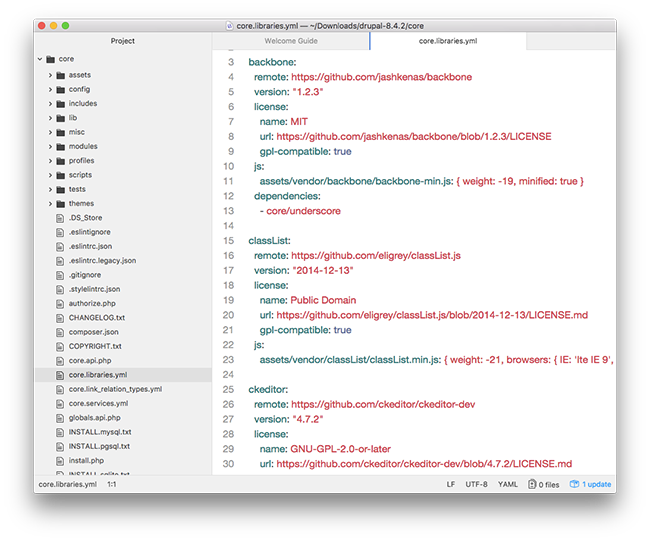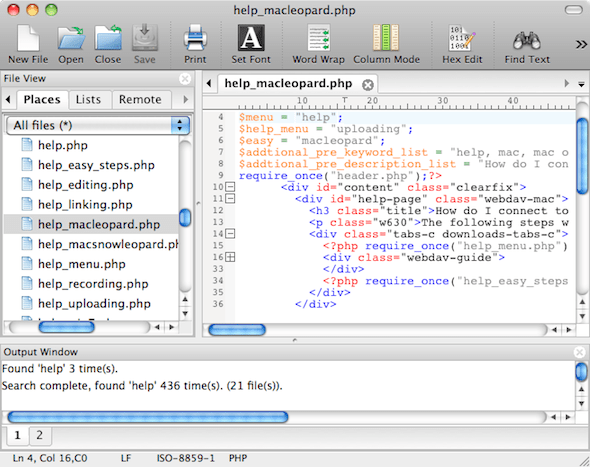
From the UI choose Configuration which is located in the sidebar, then click on Automations to go to the automation editor. Press the + sign in the lower right corner to get started. This page uses the Random sensor as an example. Any other sensor with a numeric value, can be used as well.
- YAML is just a format so you can create any text file and just add an.yml or.yaml extension. Command for creating files in zsh is touch. Touch test.yaml What people usually do is to just open a terminal text editor like nano or vim add the content and save as.yml or.yaml.
- After my upgrade to php 7.4, ext-yaml was installed, but somehow not working. Out of laziness I simply did pecl uninstall yaml and then again pecl install yaml - worked well;). – Andreas Jan 9 '20 at 0:38.
Choose a meaningful name for your automation rules.
I've installed ide-yaml. Why there is still nothing shown in Outline View when yaml opened? Please check the file exists in the Project Tree View so that it can be handled by ide-yaml. In addition, to show outline view, use Atom command Outline View: Toggle.
If the value of the sensor is greater than 10, then the automation rule should apply.
Firing a persistent notification is the result.
As “Service Data” we want a simple text that is shown as part of the notification.
Automation created or edited via the user interface, are activated immediatelyafter save the automation.
Troubleshooting missing automations
When you’re creating automations using the GUI and they don’t appear in the UI, make sure that you add back automation: !include automations.yaml from the default configuration to your configuration.yaml.
Suggest an edit to this page, or provide/view feedback for this page.
This page provides a basic overview of correct YAML syntax, which is how Ansibleplaybooks (our configuration management language) are expressed.
We use YAML because it is easier for humans to read and write than other commondata formats like XML or JSON. Further, there are libraries available in mostprogramming languages for working with YAML.
You may also wish to read Working with playbooks at the same time to see how thisis used in practice.
YAML Basics¶
For Ansible, nearly every YAML file starts with a list.Each item in the list is a list of key/value pairs, commonlycalled a “hash” or a “dictionary”. So, we need to know howto write lists and dictionaries in YAML.
There’s another small quirk to YAML. All YAML files (regardless of their association with Ansible or not) can optionallybegin with --- and end with .... This is part of the YAML format and indicates the start and end of a document.
All members of a list are lines beginning at the same indentation level starting with a '-' (a dash and a space):
A dictionary is represented in a simple key:value form (the colon must be followed by a space):
More complicated data structures are possible, such as lists of dictionaries, dictionaries whose values are lists or a mix of both:
Dictionaries and lists can also be represented in an abbreviated form if you really want to:
These are called “Flow collections”.
Ansible doesn’t really use these too much, but you can also specify a boolean value (true/false) in several forms:
Use lowercase ‘true’ or ‘false’ for boolean values in dictionaries if you want to be compatible with default yamllint options.
Values can span multiple lines using | or >. Spanning multiple lines using a “Literal Block Scalar” | will include the newlines and any trailing spaces.Using a “Folded Block Scalar” > will fold newlines to spaces; it’s used to make what would otherwise be a very long line easier to read and edit.In either case the indentation will be ignored.Examples are:
While in the above > example all newlines are folded into spaces, there are two ways to enforce a newline to be kept:
Let’s combine what we learned so far in an arbitrary YAML example.This really has nothing to do with Ansible, but will give you a feel for the format:
That’s all you really need to know about YAML to start writing Ansible playbooks.
Gotchas¶
While you can put just about anything into an unquoted scalar, there are some exceptions.A colon followed by a space (or newline) ':' is an indicator for a mapping.A space followed by the pound sign '#' starts a comment.
Because of this, the following is going to result in a YAML syntax error:
…but this will work:
You will want to quote hash values using colons followed by a space or the end of the line:
…and then the colon will be preserved.
Alternatively, you can use double quotes:
The difference between single quotes and double quotes is that in double quotesyou can use escapes:
The list of allowed escapes can be found in the YAML Specification under “Escape Sequences” (YAML 1.1) or “Escape Characters” (YAML 1.2).
The following is invalid YAML:
Further, Ansible uses “{{ var }}” for variables. If a value after a colon startswith a “{“, YAML will think it is a dictionary, so you must quote it, like so:
If your value starts with a quote the entire value must be quoted, not just part of it. Here are some additional examples of how to properly quote things:
Not valid:
Linux Yaml Editor
In addition to ' and ' there are a number of characters that are special (or reserved) and cannot be usedas the first character of an unquoted scalar: []{}>|*&!%#`@,.
You should also be aware of ?:-. In YAML, they are allowed at the beginning of a string if a non-spacecharacter follows, but YAML processor implementations differ, so it’s better to use quotes.
In Flow Collections, the rules are a bit more strict:
Boolean conversion is helpful, but this can be a problem when you want a literal yes or other boolean values as a string.In these cases just use quotes:
YAML converts certain strings into floating-point values, such as the string1.0. If you need to specify a version number (in a requirements.yml file, forexample), you will need to quote the value if it looks like a floating-pointvalue:
See also
Learn what playbooks can do and how to write/run them.
YAML Lint (online) helps you debug YAML syntax if you are having problems
Best Mac Editor For Yaml Free

Complete playbook files from the github project source
A good guide to YAML syntax
Free Yaml Editor
Questions? Help? Ideas? Stop by the list on Google Groups
#ansible IRC chat channel and #yaml for YAML specific questions

Yaml File Editor
The Specification for YAML 1.1, which PyYAML and libyaml are currentlyimplementing
For completeness, YAML 1.2 is the successor of 1.1